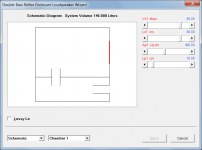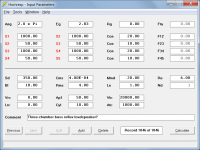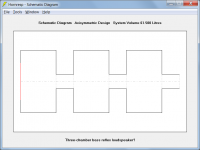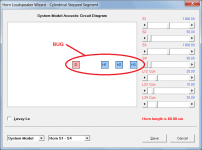Help to simulate double bass reflex
Hi
Is there anyone who can help me to simulate a double bass reflex to Lowther PM8A 15 Ohm with silver voice coil?
Fs 58 Hz
Qts 0,36
Vas 46,2 l (1,63 cubicfeet)
SPL 95,5 dB 1w/1m
Re 12,7 Ohm
Qes 0,39
Piston diam 164 mm (6,46 in)
SPL 93,5 dB 2,83 V
CMS 0,74 mm/N
Le 0,47
Qms 5,1
BL 11,1
N(0) 2,2%
MMS 10,3 gr
Hi
Is there anyone who can help me to simulate a double bass reflex to Lowther PM8A 15 Ohm with silver voice coil?
Fs 58 Hz
Qts 0,36
Vas 46,2 l (1,63 cubicfeet)
SPL 95,5 dB 1w/1m
Re 12,7 Ohm
Qes 0,39
Piston diam 164 mm (6,46 in)
SPL 93,5 dB 2,83 V
CMS 0,74 mm/N
Le 0,47
Qms 5,1
BL 11,1
N(0) 2,2%
MMS 10,3 gr
Last edited:
I'll have a look. To be honest, I don't personally find the Fostex type DBR to be especially effective; I'd suggest you look at the Augspurger type DCR or an MLTL variation before committing to the DBR type. Oddly enough, I worked up a DCR for a PM6A only last week; sent the sketch to Dave a few days back to look over. Will see if this unit may be an alternative with a few changes.
superlian - hornresp can simulate DBR by using the ABC model and shutting down a port by very small area and very long length input. Augspurger's dual chamber reflex = "ABC" type in honresp.
hi Scottmoose - have you seen these pages? what if anything might it accomplish vs MLTL of equal volume ?
Multiple-Degree of Freedom Cavity Resonator Diary
hi Scottmoose - have you seen these pages? what if anything might it accomplish vs MLTL of equal volume ?
Multiple-Degree of Freedom Cavity Resonator Diary
I have indeed.
As-is -depends. Most that I've looked into over the years have fairly characterful alignments but that's more a question of individual design rather than the broad concept itself. On paper, the more chambers you have, the wider the BW you can load so the lower the average driver excursion / the higher the power handling should be. No bad thing in itself, but it usually comes at the price of higher GD and increasing difficulties of maintaining a good alignment, which is why I tend to like MLTL variations or DCRs, since it's usually possible to get some decent loading above the nominal Fb in the main acoustic 'power band', while avoiding too many other issues. I do have some interesting varitions on the theme that Dave & I are working on at present though.
As-is -depends. Most that I've looked into over the years have fairly characterful alignments but that's more a question of individual design rather than the broad concept itself. On paper, the more chambers you have, the wider the BW you can load so the lower the average driver excursion / the higher the power handling should be. No bad thing in itself, but it usually comes at the price of higher GD and increasing difficulties of maintaining a good alignment, which is why I tend to like MLTL variations or DCRs, since it's usually possible to get some decent loading above the nominal Fb in the main acoustic 'power band', while avoiding too many other issues. I do have some interesting varitions on the theme that Dave & I are working on at present though.
Last edited:
hornresp can simulate DBR by using the ABC model and shutting down a port by very small area and very long length input.
Hi freddi,
I'm intrigued
Wouldn't it be easier to just use the actual DBR loudspeaker configuration option?
Kind regards,
David
Attachments
that was an old sim entry with his Lowther spec - plus forgot !!
Ah, now I understand - thanks
David - I've likely asked before but is there a way so simulate a 3-chamber bass reflex with hornresp ?
Hi freddi,
I'm not sure how you define your 3-chamber bass reflex topology, but if it is simply a third ported chamber added in series to a conventional DBR system, then such a design could be modelled in Hornresp as shown in Attachments 1 and 2.
Note that this particular design has brought to light a bug in the new system model schematic, which hopefully will be fixed in the next update
Kind regards,
David
Attachments
Thanks David. FWIW I was thinking of extending the dual chamber reflex type with one more chamber. A non tech late friend did that as he said "designed on acid" for two five inch and two 1" domes - it sounded very good
3CR-Ti | Parts Express Project Gallery
That's definitely one for AkAbak
- Status
- This old topic is closed. If you want to reopen this topic, contact a moderator using the "Report Post" button.
- Home
- Loudspeakers
- Full Range
- Help to simulator double bass reflex









